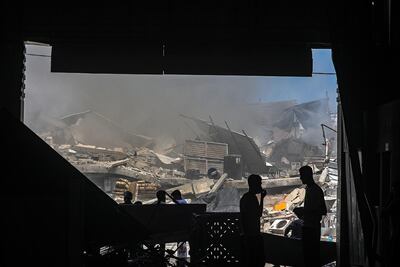It was a strange spectacle: a Palestinian man in Gaza receiving a phone call from the Israeli army to tell him his building was about to be blown up in an air strike.
The man was asking for his building to be hit in a way so that it would collapse backwards into an empty area.
“In a little while the big blow will take place,” the caller said in Arabic, warning the owner of the tower bloc to leave as soon as possible. "Inshallah [God willing] it will fall on its back."
“Don’t hit from the front,” the man pleaded as people around him listened attentively.
“I don’t know,” the caller replied as the man asked why his building was being targeted, protesting that it did not house offices of the Palestinian militant group Hamas.

Such phone calls are a common and controversial method for the Israeli military to warn people in Gaza of impending air strikes on buildings. Israeli drones then fire a couple of warning rockets at the building before missiles hit it from the front or the back, or sometimes from both sides, as happened on Thursday when an air strike flattened the evacuated Al Shorouk tower bloc.
Israel says it is targeting buildings where Hamas has offices and weapons stores. The early warnings and state-of-the-art precision-guided rockets and missiles greatly reduce civilian casualties, the military says, although no alerts are issued for strikes on Hamas leaders and fighters.
Gazans say such strikes are a human rights breach that the world does nothing to stop. There are already more than two million people living in the 41 kilometre-long coastal strip, and with the population growing and unable to leave because of an Israeli blockade since 2007, many more of its people are living in multiple-storey buildings.
The deliberate targeting of civilian objects and extensive, unjustified destruction of property are war crimes and a breach of international law, and Israel’s warning system should not absolve it of liability, the rights group Amnesty International says.
"There is no way that firing a missile at a civilian home can constitute an 'effective warning'. Amnesty International has documented cases of civilians killed or injured by such missiles in previous Israeli military operations on the Gaza Strip," Maen Hammad, regional campaigner for Amnesty International, told The National.
“Effective advance warning to civilians is only one of the prescribed precautions in attacks aimed at minimising harm to civilians. When Israeli forces have given warning, in many cases key elements of effective warning have been missing, including timeliness, informing civilians where it is safe to flee, and providing safe passage and sufficient time to flee before an attack. There also have been reports of lethal strikes launched too soon after a warning to spare civilians.”
No warnings
Gaza’s civilians are facing another Israeli onslaught since Hamas seized control of the territory in 2007. The previous major escalation was in 2014, which devolved into a devastating war that killed more than 2,000 Palestinians and 70 Israelis, mostly soldiers.
The latest attacks follow an escalation of Israeli-Palestinian tension in occupied East Jeruslaem and the firing of hundreds of rockets from Gaza into Israel since Monday evening. Israel said it has responded with hundreds of air strikes.
Not all strikes are preceded by a warning. A sudden strike on Thursday night that levelled a two-storey building in Al Bureij refugee camp, central Gaza city, killed at least six people, including two children under 10.
"It was a sudden double explosion with two missiles. We hadn't received any form of warning, either a warning rocket or a phone call. The house belongs to a former head of Al Bureij refugee camp municipality. His wife and two daughters were killed and civil defence forces of Hamas also pulled body parts of other men," Khaled Al Zughir, who also lives in the camp, told The National.
“No huge damage has been done to neighbouring buildings, just windows were blown out,” he added. “They know the phone number of every single person in Gaza; they have their own eyes on the ground. They can even hit one single room in an entire building if they want."

Despite international calls for de-escalation, Israel and Gaza militants have continued their attacks. Israel has massed troops on Gaza’s borders for a possible invasion. International human rights watchdogs say both sides are violating international law.
Images of Gazans once again leaving their houses near the border areas, including women carrying toddlers, children and elderly people, have again started cropping up online – scenes that recall past Hamas-Israel conflicts in 2008 and 2014.
Gaza’s Health Ministry said the death toll has climbed to 139, including 39 children and seven women, with more than 1000 people wounded.
Eight people have been killed in Israel. Among them were a soldier killed by an anti-tank missile and a 6-year-old child hit in a rocket attack.
The current tense atmosphere has a similar feel to the previous wars in Gaza.
Gazans are witnessing a gradual reversion to the painful conditions following the two earlier conflicts as the ongoing Israeli air strikes have damaged hundreds of apartments and reduced many buildings to rubble, leaving people homeless and creating a looming housing crisis.
Rebuilding in the past was not easy as Israel prevented the entry of construction materials into Gaza, fearing that Hamas might use them to develop weapons.
“We will wait until this new aggression ends,” said Mr Al Zughir. “It’s so dispiriting but we have to find ways to start rebuilding all over again.”

